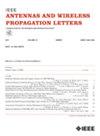一种高带外抑制选择性滤波贴片天线
IF 4.8
2区 计算机科学
Q2 ENGINEERING, ELECTRICAL & ELECTRONIC
引用次数: 0
摘要
本文介绍了一种具有增强带外抑制、高选择性和简单结构的高性能滤波天线。该天线由介电基板上表面的辐射贴片和基板下侧的寄生存根组成。通过利用三共振模式,带宽显着增强。通过在辐射贴片上刻蚀一对对称的l型槽来激发低频共振模式。中频共振模式对应于主辐射贴片的基模。高频谐振模式是通过在介电衬底下引入四分之一波长开路矩形短段而产生的。此外,这两种结构分别在低频段和高频频段的边缘引入辐射零。附加的t形和u形存根通过特定边缘的辐射零提高波段选择性。所提出的滤波天线已经构造并进行了测试。测试表明,−10 dB阻抗带宽为17.7% [(2.26 ~ 2.7)GHz],峰值增益为8.14 dBi,频率选择性超过252 dB/GHz,带外增益低于−10.5 dB。本文章由计算机程序翻译,如有差异,请以英文原文为准。
A High Out-of-Band Suppression and Selective Filtering Patch Antenna
This letter presents a high-performance filtering antenna with enhanced out-of-band suppression, high selectivity, and a simple structure. The antenna is composed of a radiating patch on the top surface of the dielectric substrate and parasitic stubs on the underside of the substrate. By utilizing a triple-resonance mode, bandwidth is significantly enhanced. The low-frequency resonance mode is excited by etching a pair of symmetric L-shaped slots in the radiating patch. The mid-frequency resonance mode corresponds to the fundamental mode of the main radiating patch. The high-frequency resonance mode is generated by introducing a quarter-wavelength open-circuit rectangular stub beneath the dielectric substrate. Additionally, these two structures introduce radiation nulls at the edges of the low- and high-frequency bands, respectively. Additional T-shaped and U-shaped stubs improve band selectivity with radiation nulls at specific edges. The proposed filtering antenna has been constructed and tested. Testing reveals a −10 dB impedance bandwidth of 17.7% [(2.26 to 2.7) GHz], 8.14 dBi peak gain, the frequency selectivity exceeds 252 dB/GHz and an out-of-band gain below −10.5 dB.
求助全文
通过发布文献求助,成功后即可免费获取论文全文。
去求助
来源期刊
CiteScore
8.00
自引率
9.50%
发文量
529
审稿时长
1.0 months
期刊介绍:
IEEE Antennas and Wireless Propagation Letters (AWP Letters) is devoted to the rapid electronic publication of short manuscripts in the technical areas of Antennas and Wireless Propagation. These are areas of competence for the IEEE Antennas and Propagation Society (AP-S). AWPL aims to be one of the "fastest" journals among IEEE publications. This means that for papers that are eventually accepted, it is intended that an author may expect his or her paper to appear in IEEE Xplore, on average, around two months after submission.

 求助内容:
求助内容: 应助结果提醒方式:
应助结果提醒方式:


